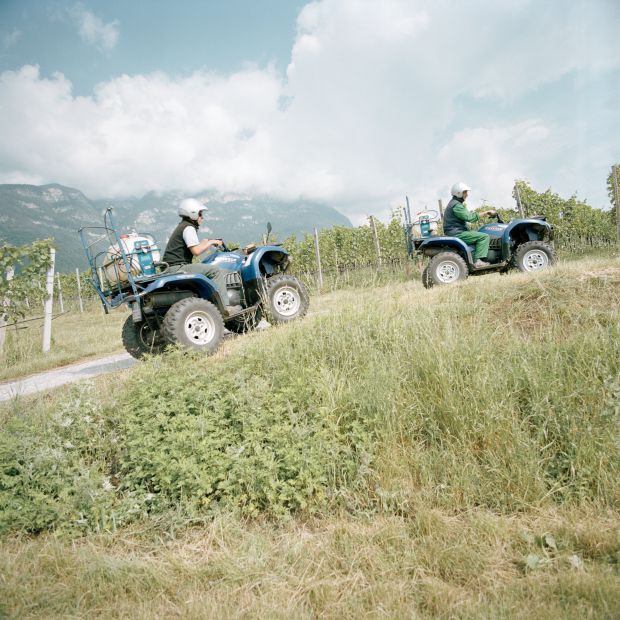"The sheep provide natural manure and introduce their animal souls into the vineyards. One day we will also reintroduce horses."
Michael Count Goëss-Enzenberg
On the wild side
Biodynamics explained hands-on: a walk trough Manincor
Something was wrong in the vineyards. It made little difference whether the summer was more or less sunny, wet or dry, the grapes had problems to attain the quality prerequisites necessary to produce a top wine. However precisely we followed the rules, the results seldom met our expectations.
According to Dr. Andrew C. Lorand (1), decades of using chemical fertilisers have destroyed microbial life in the soils. Where are the vines supposed to draw strength to produce superlative quality grapes?
Back to the present, winter 2010; the Lake of Kaltern is frozen over, to the joy of skaters. On a stroll through the vineyard with Count Michael Goëss-Enzenberg he explains how he took the decision to change over the entire production to biodynamic farming methods.

In search of the lost terroir
Concerned about the quality of his grapes he noticed how Countess Sophie kept the family healthy almost without any medical aid, simply with high quality food, fresh air and above all attention to individual needs. And when necessary, with homeopathy and old household remedies. Could the same principles work with vines?
Andrew Lorand recommended a radical cure: changing to biodynamic winegrowing. A start was made in 2005, 2006 was the first year in which the all vineyards were cultivated on biodynamic lines, and since 2009 the entire estate has been legally certified as 100% biodynamic.
However, there was plenty of persuasion work to be done in the estate. The concept of biodynamic husbandry only works when it is supported by an inner attitude towards nature. When biodynamic methods were introduced the older workers were the least convinced. “Count, do you really want to let everything go to rack and ruin?” The 80 year-old has been working at Manincor for 65 years and even today he never misses a day’s work. Then, after the first successful biodynamic harvest, he opined: “That’s how we used to do it”. Of course vineyards “used to” be worked with animals, compost was made and people paid attention to the rhythms of nature and moon cycles.
Shortly afterwards growers gladly adopted methods of combating ailments and pests with less work but more use of chemicals. New problems were treated using constantly new means.

As a result the soils became sick, the vineyards lost their vitality. Growers replaced the last beasts of burden with tractors at the beginning of the 1970s; since then a few hens and the dog have remained. However, biodynamic agriculture requires a holistic mindset, thinking in cycles and diversity. Plants need an environment which is as complete as possible – healthy soils with established populations of beneficial organisms, creatures which use the vineyard as a habitat or which aid in working it.
The conversion is now complete at Manincor. The walker espies a flock of sheep among the naked vines, small Breton Quessants which are ideal for life in the vineyard thanks to their hardiness. “It’s got nothing to do with bucolic ideals”, the count remarks. “The sheep provide natural manure and introduce their animal souls into the vineyards. One day we will also reintroduce horses”.
There is brightly-coloured beehive on the edge of a slope, set up two years ago. The honey is available in the estate shop. The diversity of plants which have appeared in the vineyard in the meantime provide a paradise for bees. Bee colonies from elsewhere also spend the season among the vines. The numerous nesting boxes are also popular among bird species living around the Lake of Kaltern.
Today nobody believes anymore in the laissez-faire and hands-off attitude which characterised the beginnings of biological agriculture. In fact the exact opposite is required: intensive hard work, discipline, accuracy and precision. Everything must be done at the right time; the ideal moon phases must be used for the application of teas and biodynamic preparations.
Living biodiversity
The UNO has declared 2010 as the year of biodiversity and Manincor can be presented as a paragon. Vineyards are interspersed with groups of trees and hedges; the ground in every second row of vines is tilled and a mixture of corn, flowers, clover, rape and other seeds are spread on the soil. Together with compost they provide an ideal nutrient medium for vines.
The change-over to biodynamic agriculture at Manincor entailed far more than a simple change in vineyard husbandry methods. According to Count Michael: “Biodynamics requires people to dedicate themselves to their work with complete awareness. We are talking about natural cycles.” For example when oak is cut from the hill surmounted by Leuchtenburg Castle overlooking the Lake of Kaltern to make casks, the waste wood is turned into wood chips for heating; or when compost is made – bio producers have been allowed to compost their own grape skins since 2009.

Work in progress
Consequently biodynamic agriculture is a work in progress. There is still plenty left to do but at Manincor it is already apparent that the mind-set of thinking in cycles has become a matter of course. Slowly this often arduous path we have chosen is bringing its rewards. For example the prestigious Italian wine guide ‘Guida ai Vini d’Italia bio 2010’ has singled out Manincor as producer of Italy’s best biological white wine, and ‘Gambero Rosso’ has awarded us the first ‘green’ 3 Glasses.

(1) Andrew Lorand: having practiced agriculture and winegrowing in Switzerland he studied agro-ecology in the USA and lectures on biodynamics. Today he is a lecturer and advises numerous prestigious biodynamic wine estates.

